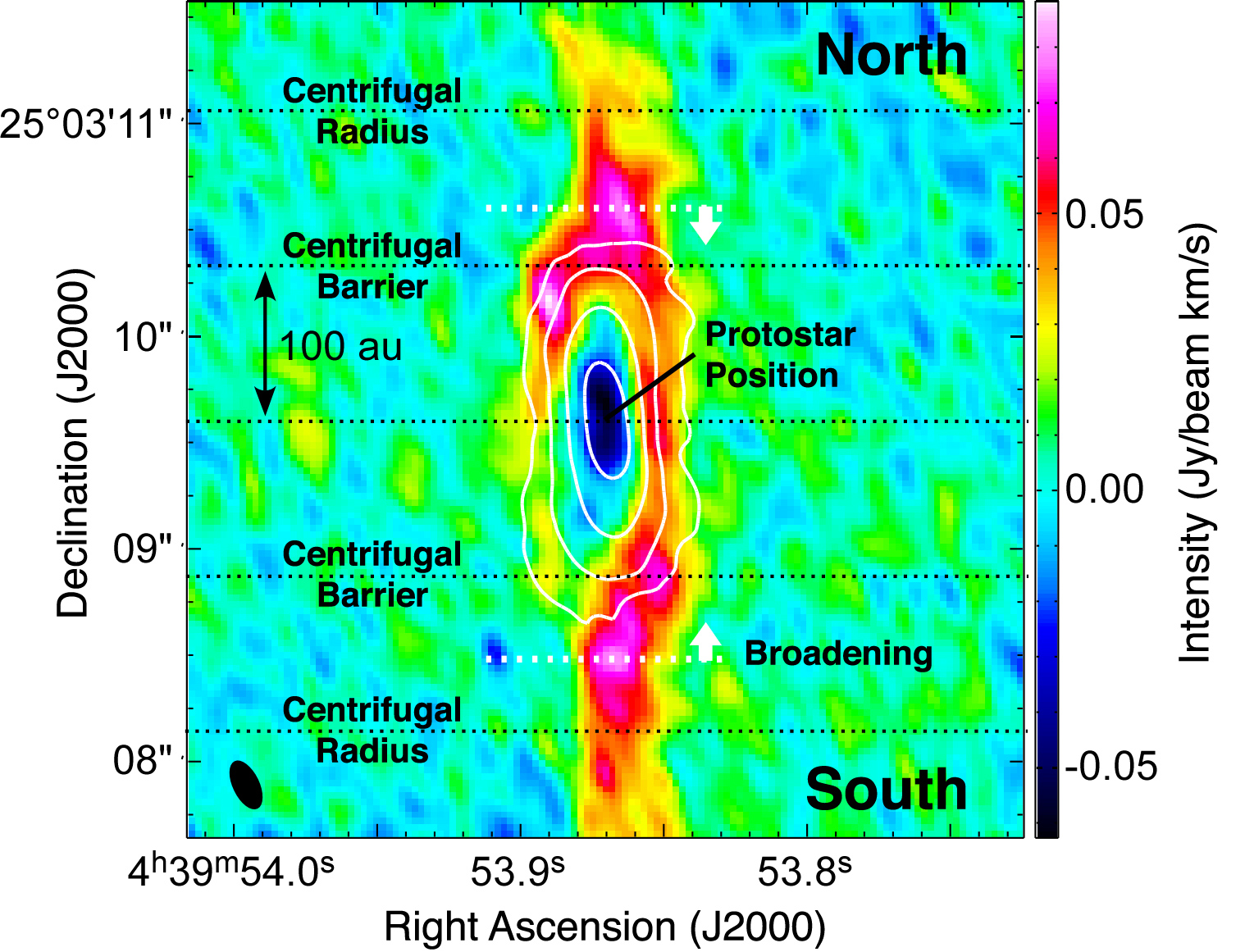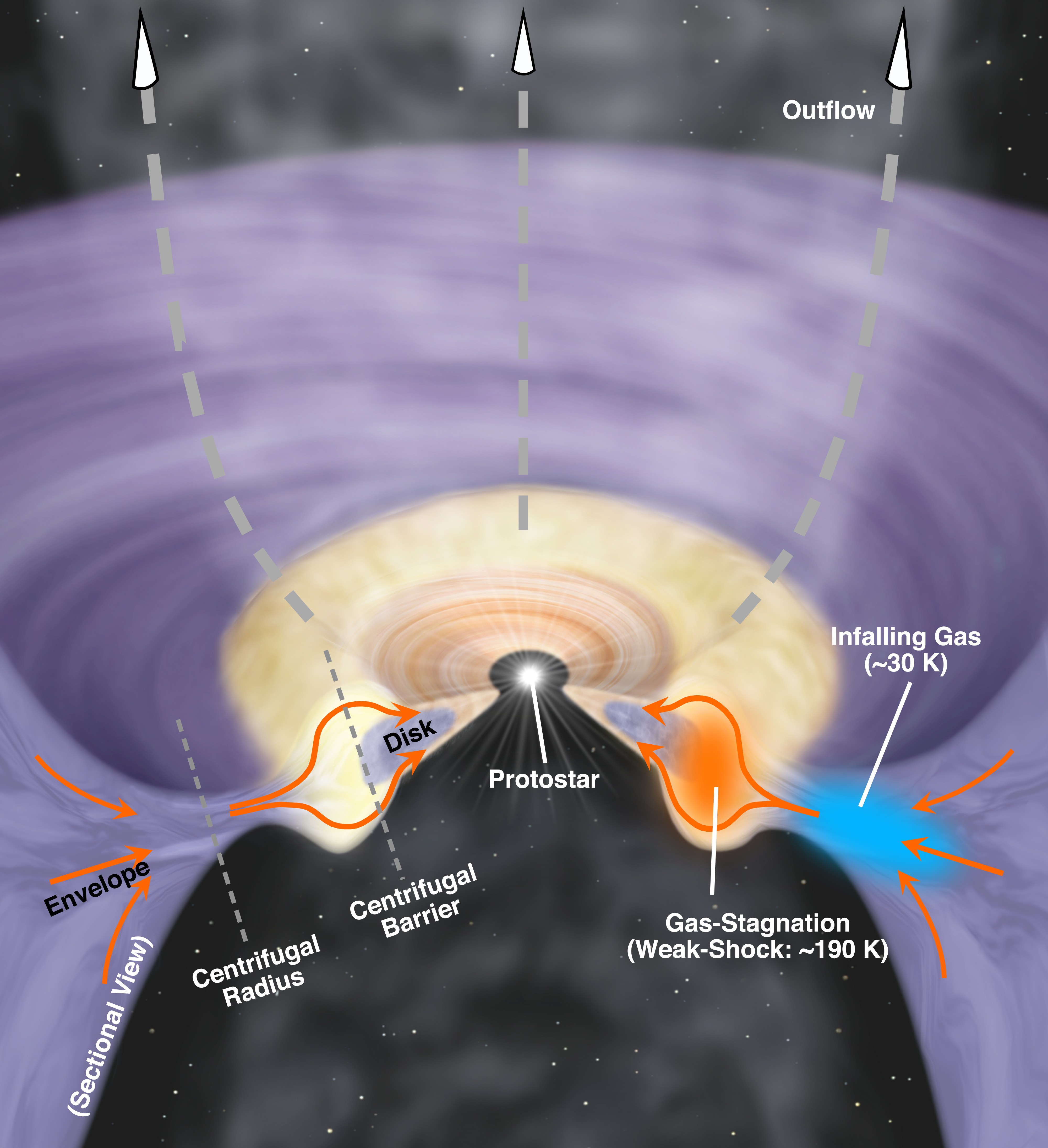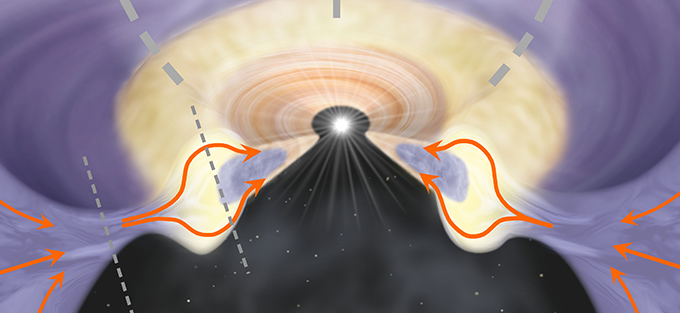ALMA Reveals the Structure of a Low-Mass Protostar System
A team of astronomers used the Atacama Large Millimeter/submillimeter Array (ALMA) to observe the almost edge-on system of the low-mass protostar L1527. This protostar is in a star forming region in the Taurus molecular cloud, about 450 light years away and has a spinning protoplanetary disk, almost edge-on to our view, embedded in a large envelope of molecules and dust. ALMA allowed the researchers to resolve for the first time the structure of this young stellar system.
One of the big puzzles in astrophysics is how stars like the Sun manage to form from collapsing molecular clouds in star-forming regions of the Universe. The puzzle is known technically as the angular momentum problem in stellar formation. The problem essentially is that the gas in the star-forming cloud have some rotation, which gives each element of the gas an amount of angular momentum. As they collapse inward, eventually they reach a state where the gravitational pull of the nascent star is balanced by the centrifugal force, so that they will no longer collapse inward of a certain radius unless they can shed some of the angular momentum. This point is known as the centrifugal barrier.
Now, using measurements taken by ALMA’s radio antennas, a group led by Nami Sakai of the RIKEN Star and Planet Formation Laboratory has found clues as to how the gas in the cloud can find their way to the surface of the forming star. To gain a better understanding of the process, Sakai and her group turned to the ALMA observatory, a network of 66 radio dishes located high in the Atacama Desert of northern Chile. The dishes are connected in a carefully choreographed configuration so that they can provide images on radio emissions from protostellar regions around the sky.

Previously, Sakai had discovered, from observations of molecules around the same protostar, that unlike the commonly held hypothesis, the transition from envelope to the inner disk—which later forms into planets—was not smooth but very complex. “As we looked at the observational data,” says Sakai, “we realized that the region near the centrifugal barrier—where particles can no longer infall—is quite complex, and we realized that analyzing the movements in this transition zone could be crucial for understanding how the envelope collapses.”
The new observations show a broadening of the envelope in the transition zone between the inner disk and the outer envelope. Sakai compares it to a “traffic jam in the region just outside the centrifugal barrier, where the gas heats up as the result of a shock wave.” And he adds that “It became clear from the observations that a significant part of the angular momentum is lost by gas being cast in the vertical direction from the flattened protoplanetary disk that formed around the protostar.”

This behavior accorded well with digital simulations the group had done using a purely ballistic model, where the particles behave like simple projectiles that do not need to be influenced by magnetic or other forces.
Sakai plan to continue to use observations from the powerful ALMA array “to further refine the understanding of the dynamics of stellar formation and fully explain how matter collapses onto the forming star. This work could also help to better understand the evolution of our own Solar System.”
Additional information
The research was published in the Monthly Notices of the Royal Astronomical Society published by Oxford University Press as Sakai, Nami et al., Vertical Structure of the Transition Zone from Infalling Rotating Envelope to Disk in the Class 0 Protostar, IRAS04368+2557.
The Atacama Large Millimeter/submillimeter Array (ALMA), an international astronomy facility, is a partnership of the European Organisation for Astronomical Research in the Southern Hemisphere (ESO), the U.S. National Science Foundation (NSF) and the National Institutes of Natural Sciences (NINS) of Japan in cooperation with the Republic of Chile. ALMA is funded by ESO on behalf of its Member States, by NSF in cooperation with the National Research Council of Canada (NRC) and the Ministry of Science and Technology (MOST) in Taiwan and by NINS in cooperation with the Academia Sinica (AS) in Taiwan and the Korea Astronomy and Space Science Institute (KASI).
ALMA construction and operations are led by ESO on behalf of its Member States; by the National Radio Astronomy Observatory (NRAO), managed by Associated Universities, Inc. (AUI), on behalf of North America; and by the National Astronomical Observatory of Japan (NAOJ) on behalf of East Asia. The Joint ALMA Observatory (JAO) provides the unified leadership and management of the construction, commissioning and operation of ALMA.
Contacts
-
Dr. Nami Sakai
RIKEN Star and Planet Formation Laboratory, JapanPhone: +81-(0)48-467-1411Email: [email protected] -
Nicolás Lira
Education and Public Outreach OfficerJoint ALMA Observatory, Santiago - ChilePhone: +56 2 2467 6519Cel: +56 9 9445 7726Email: [email protected] -
Masaaki Hiramatsu
Education and Public Outreach Officer, NAOJ Chile -
Richard Hook
Public Information Officer, ESOGarching bei München, GermanyPhone: +49 89 3200 6655Cel: +49 151 1537 3591Email: [email protected] -
Charles E. Blue
Public Information OfficerNational Radio Astronomy Observatory Charlottesville, Virginia - USAPhone: +1 434 296 0314Cel: +1 202 236 6324Email: [email protected]

